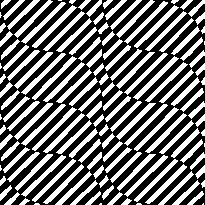
Chapter 1.3
Classification of Symmetry ? Transformations and Groups
As the basis for the classification of the symmetry groups G three elements were taken into consideration: the types of symmetries (isometries, similarity symmetries, conformal symmetries) that occur in G, the space on which the group G acts, and the sequence of maximal included proper subspaces, invariant with respect to the group G. According to this, the Bohm symbols (J. Bohm, K. Dornberger-Schiff, 1966) are used for the categorization of the groups of isometries. Symbols of the same type are applied to the similarity symmetry and conformal symmetry groups. For example, the symmetry group of square D4 acts in plane and possesses only one invariant point, so it belongs to the category G20 – the symmetry groups of rosettes.
A transformation S is an isometry of certain space En (Sn) if for every two points P, Q of that space |P,Q| = |S(P),S(Q)| holds, where |P,Q| denotes the length of the line segment defined by points P, Q. All isometries of some space form a group.
A transformation S of n-dimensional space is called indirect (or reflective, sense reversing, opposite, odd) if it transforms any oriented (n+1)-point system onto an oppositely oriented (n+1)-point system (line segment AB onto BA, triangle ABC onto ACB, tetrahedron ABCD onto ACBD in cases of n = 1,2,3 respectively). Otherwise, it is called direct (sense preserving, even) (Figure 1.6).
?

Figure 1.6
| (a) Direct and (b) indirect plane isometry. |
As an elementary isometric transformation we can take the reflection, non-identical isometry of space En (Sn) for which, every point of its subspace En-1 (Sn-1) is an invariant point. In particular, for n = 1 we have point reflection, for n = 2 line reflection (or simply – reflection), for n = 3 plane reflection, involutional indirect isometries. According to the fundamental theorem on minimal or canonic representation of an isometric transformation of space En (Sn), which states that every isometry of this space can be presented as a composition of maximum n+1 (plane) reflections, it is possible to classify the isometries of different spaces.
The classification of isometric transformations and corresponding symmetry groups is common for spaces En, Sn, Ln for n < 2, while for n 2 different possibilities of relations of disjoint lines, which are defined by the axiom of parallelism, condition specific differences. This work exclusively discusses Euclidean spaces.
In the space E2 (plane) we distinguish the following isometric transformations (Figure 1.7):
?
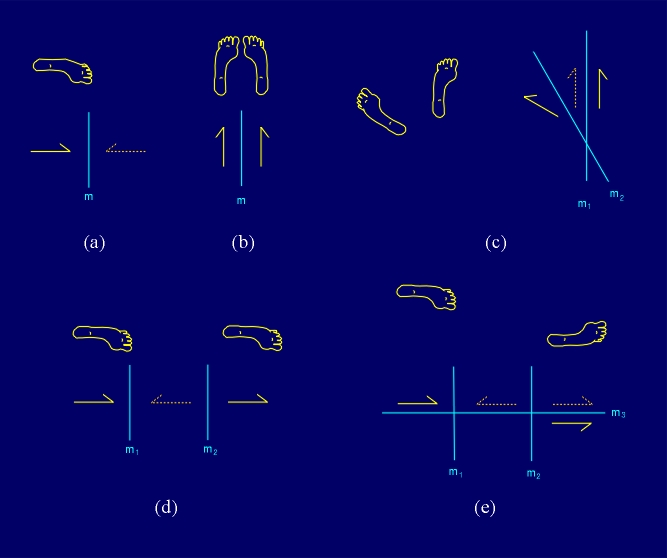
Figure 1.7
| (a) Identity transformation; (b) reflection; (c) rotation; (d) translation; (e) glide reflection. |
1) identity transformation E, with the minimal reflectional representation of the length 2 (R2 = E);
2) reflection R;
3) rotation S = R1R2, the product of two reflections in the reflection lines crossing in the invariant point (center of rotation). The oriented angle of rotation is equal to twice the angle between the reflection lines R1, R2;
4) translation X = R1R2, the product of two reflections with parallel reflection lines, such that the translation vector is perpendicular to them and equal to twice the oriented distance between the reflection lines R1, R2;
5) glide reflection P = R3X = XR3 = R1R2R3, the commutative product of a translation X and a reflection R3 with the reflection line parallel to the translation axis.
With respect to the invariant figures, all the points of the plane E2 are invariant points of the identity transformation E, reflection R maintains the invariance of all the points of the reflection line, rotation S possesses a single invariant point – the center of rotation, while translation and glide reflection have no invariant points. A glide reflection possesses a single invariant line – the axis, and a translation keeps invariant all the lines parallel to the translation axis.
In the case of rotation, if the relation S = R1R2 = R2R1 holds, i.e. if the reflection lines R1, R2 are perpendicular, as a result we get the special involutional rotation – central reflection Z (two-fold rotation, half-turn, point-reflection) (Figure 1.8).
?
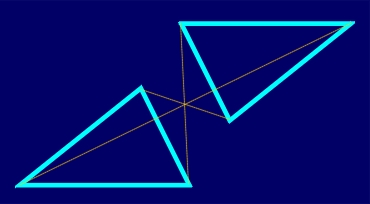
Figure 1.8
| Central reflection Z. |
When orientation is considered we distinguish direct transformations (or sense preserving transformations): identity transformation E, translation, rotation, and indirect transformations (sense reversing transformations): reflection and glide reflection. Since direct transformations are the product of an even, and the indirect ones of an odd number of reflections, we can call them respectively even and odd transformations.
If a symmetry transformation S can be represented as a composition S = S1Sn such that SiSj = SjSi, i,j = 1,,n, we can call it a complex or composite transformation while the transformations S1,,Sn we call the dependent transformations or dependent elements of symmetry. We will use such approach whenever we are interested to learn to what degree the dependent elements of symmetry influence the characteristics of the composite transformation, and whether they have lost or preserved their geometric and visual characteristics during it. For example, a glide reflection is such commutative composition of translation and reflection, with reflection line parallel to the translation axis.
An analogous procedure makes possible the classification of isometries of the space E3, where each isometry can be represented as the composition of four plane reflections at the most. Besides the transformations of the space E2 afore mentioned with the line reflections substituted by plane reflections, as the new transformations of the space E3 we have two more transformations. They are a direct isometry – twist (screw), the commutative composition of a rotation and a translation, the canonic representation of which consists of four plane reflections and indirect isometry – rotatory reflection, the commutative composition of a rotation and a plane reflection in the plane perpendicular to the rotation axis, the canonic representation of which consists of three plane reflections. In particular, the involutional rotatory reflection, which is the composition of three plane reflections of which every two commute, is called point inversion Z (or rotatory inversion).
For every element S1 of a transformation group G we can define the conjugate of the element S1 by an element S as the product S-1S1S, which we denote by S1S. If S1S G, then the mapping S1 onto S1S represents an automorphism of the group G. If the element S by means of which this automorphism is being realized belongs to the group G, such an automorphism is called an internal automorphism. Any other automorphism of a group G is called an external automorphism. An important characteristic of a conjugate is that the order of the conjugate S1S is equal to the order of the element S1. If a figure f is invariant under a transformation S1, then S(f) is the figure invariant under transformation S1S. The conjugate of a reflection R with invariant reflection line p, derived by isometry S, is the reflection RS with the invariant reflection line S(p). Hence we can conclude that the isometry S1 and all its conjugates S1S derived by different isometries S constitute one class of equivalence, i.e. the class of isometries having the same name, which means that (internal) automorphism of a group of isometries G transforms reflections onto reflections, rotations onto rotations, etc. The properties of the (internal) automorphisms are frequently used when proving theorems on isometric transformations and the other symmetry transformations. For example, by gR, g G, is defined an internal automorphism of the symmetry group of square G, given by presentation
{S,R} S4 = R2 = (RS)2 = E: ER = E, RR = R, (RS)R = SR, ? (SR)R = RS, SR = S3, (S2)R = S2, (S3)R = S.
In the same way, it is defined an external automorphism of the rotational group of square H, given by presentation
{S} S4 = E, SR = S3, (S2)R = S2, (S3)R = S,
where the reflection line of reflection R contains the center of four-fold rotation S. Hence, external automorphisms are very efficient tool for extending symmetry groups.
Since the product of direct transformations is a direct transformation, and the inverse of a direct transformation is a direct transformation, each group of transformations G, which contains at least one indirect transformation has a subgroup of the index 2, denoted by G+, which consists of direct transformations of the group G. For example, the rotational subgroup of sqare H satisfies this condition regarding the symmetry group of square, so H = G+, [G:H] = 2. All direct isometries of the space En can be identified as movements of a material object in the space En, as opposed to indirect isometries which do not have such a physical interpretation (e.g., a plane reflection does not represent motion in E3).
For a figure f with the symmetry group Gf, which consists only of direct symmetries, it is possible to have the enantiomorphism – enantiomorphic modifications of a figure f, i.e. to have the “left” and “right” form of the figure f (Figure 1.9). The existence of indirect symmetries of a figure f implies the absence of enantiomorphism.
Since reflections have a role of elementary isometric transformations, while all other isometries are their finite compositions, of special interest will be symmetry groups generated by reflections – groups, a set of generators of which consists exclusively of reflections. Since every reflection keeps invariant each point of the reflection line, the fundamental region of these groups will possess a fixed shape, will not allow variations and will have rectilinear edges. All symmetry groups will be subgroups of groups generated by reflections. In the case of conformal symmetry groups, along with reflections, circle inversions have the analogous function. For example, the symmetry group of square is the group generated by reflections, with the fundamental region of the fixed shape (Figure 1.3a).
?
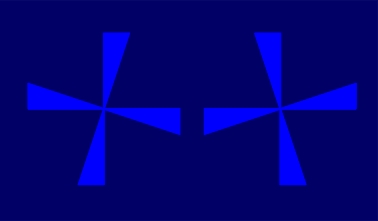
Figure 1.9
| “Left” and “right” rosette with the symmetry group C4, consisting of direct symmetries. |
The results of composition of plane isometries are different categories of groups of isometries of the space E2, represented by Bohm symbols as: G210 – symmetry groups of finite friezes, G20 – symmetry groups of rosettes, G21 – symmetry groups of friezes and G2 – symmetry groups of ornaments. Because of the relation G210 G20, in this work we will discuss only the categories G20, G21, G2, while the category G210 will be discussed within the category G20. The definitions of symmetry groups will be derived directly from Bohm symbols: symmetry groups of rosettes are groups of isometries of the space E2 (plane) with an invariant 0-dimensional subspace (point), symmetry groups of friezes are groups of isometries of the space E2 with an invariant 1-dimensional subspace (line) and without invariant points, while symmetry groups of ornaments are groups of isometries of the space E2 without invariant subspaces (points, lines). The groups of the category Gn are called the space groups, the groups of the category Gn1 the line groups, and the groups of the category Gn0 the point groups of the space En. With symmetry groups of friezes G21 and symmetry groups of ornaments G2, a group contains one or two generating translations respectively, so that each of these groups has a translational subgroup. A lattice is the orbit of a point with respect to a discrete group of translations. For the friezes it is a linear series of equidistant points while for ornaments we get a plane lattice or simply a lattice. Five different symmetry types of plane lattices bear the name of Bravais lattices; the points of these lattices are defined by five different isohedral tessellations, which consist of parallelograms, rhombuses, rectangles, squares or regular hexagons. To Bravais lattices correspond the crystal systems of the same names (Figure 1.10).
?
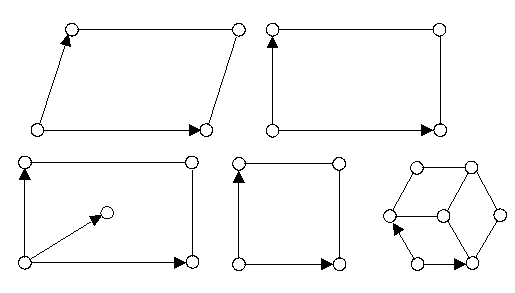
Figure 1.10
| Five plane Bravais lattices. |
Because the symmetry groups of friezes G21 are groups of isometries of the plane E2 with an invariant line, they cannot have rotations of an order greater than 2.
For the symmetry groups of ornaments G2 so-called crystallographic restriction holds, according to which symmetry groups of ornaments can have only rotations of the order n=1,2,3,4,6. The term “crystallographic groups” is used for all groups which satisfy this condition, despite the category they belong to.
In isometry groups all distances between points under the effect of symmetries remain unchanged and the congruence of homologous figures is preserved. Consequently, the same holds for all other geometric properties of such figures, so that the equiangularity (the congruence of the angles of homologous figures) and their equiformity (the same form of homologous figures) are the direct consequences of isometrism.
The next class of symmetry groups we shall consider are the similarity symmetry groups. A similarity transformation of the space En is a transformation which to each line segment of length AB assigns a line segment of the length kAB whereby k is a real positive number, the coefficient of similarity. In particular, if k = 1 then a similarity transformation is an isometry. According to the theorem on the existence of an invariant point of every similarity transformation which is not an isometry, there are, besides isometries, three types of similarity symmetry transformations of the space E2:
(i) central dilatation K (or simply dilatation), a transformation which to each vector (A,B) assigns the vector (A’,B’), such that A’ = K(A), B’ = K(B) and (A’,B’) = k(A,B), where the coefficient of the dilatation is k \{-1,0,1} ;
(ii) dilative rotation L, the commutative composition of a central dilatation K and a rotation, with a common invariant point;
(iii) dilative reflection M, the commutative composition of a dilatation K and a reflection in the reflection line containing the invariant point (center) of the dilatation K (Figure 1.11).
?
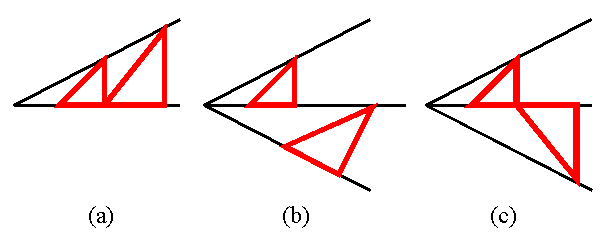
Figure 1.11
| (a) Dilatation; (b) dilative rotation; (c) dilative reflection. |
Those transformations are, in the given order, isomorphic with the isometries of the space E3: translation, twist and glide reflection. They make possible the extension of the symmetry groups of rosettes G20 by the external automorphism, having as the result similarity symmetry groups S20 that we will, thanks to the existence of the invariant point, call the similarity symmetry groups of rosettes.
Dilatations K and dilative rotations L are direct, while dilative reflections M are indirect transformations. They all possess the properties of equiangularity and equiformity. All other aspects of similarity symmetry groups (the problems of enantiomorphism, fundamental regions, tessellations,) will be discussed analogously to the case of isometry groups.
Further generalization leads to conformal transformations or circle preserving transformations of the plane E2\{O} ; for them the property of equiangularity has been preserved, but not that of equiformity. We have, as the elementary transformation of conformal symmetry in E2\{O} , the circle inversion RI (or simply inversion) – an involutional transformation isomorphic with a reflection, that gives to each point A in the plane E2\{O} a point A1 so that (O,A)(O,A1) = r2, where r is the radius of the inversion circle c(O,r) and O is the singular point of the plane E2\{O} (Figure 1.12). Just like a reflection, for which each point of the reflection line is invariant, an inversion maintains invariant each point of the inversion circle. By discussing a line as a circle with an infinite radius (and treating as circles, at the same time and under the same term, circles and lines) it is possible to identify reflections with circle inversions. In such a case, all circle inversions (including line reflections) and their compositions, can be discussed as circle preserving transformations, i.e. transformations mapping circles (including lines) onto circles.
?
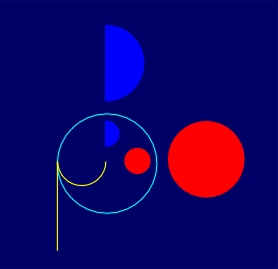
Figure 1.12
| Circle inversion. |
Besides the circle inversion RI, by composing it with isometries maintaining invariant the circle line c of the inversion circle c(O,r) – with a reflection with reflection line containing the circle center O or with a rotation with the rotation center O, we have two more conformal transformations:
(i) inversional reflection ZI = RIR = RRI, the involutional transformation, the commutative composition of a reflection and a circle inversion;
(ii) inversional rotation SI = SRI = RIS, the commutative composition of a rotation and a circle inversion (Figure 1.13).
?
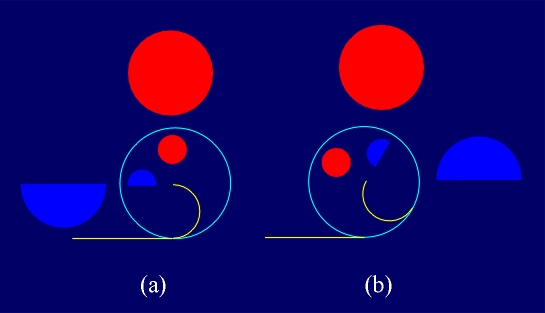
Figure 1.13
| (a) Inversional reflection; (b) inversional rotation. |
Those three conformal symmetry transformations, besides isometries and similarity symmetry transformations, constitute the finite and infinite conformal symmetry groups C21, C2 – conformal symmetry groups of rosettes in E2\{O} .
As an extension of the symmetry groups of rosettes G20 we have the finite conformal symmetry groups C21 isomorphic with the symmetry groups of tablets G320. As a further extension of finite conformal symmetry groups C21 by the similarity symmetry transformations K, L, M, we get the infinite conformal symmetry groups C2. The similarity symmetry groups S20 and the infinite conformal symmetry groups C2 are isomorphic with the line symmetry groups of the space E3 – the symmetry groups of rods G31. In line with the isomorphism mentioned, all similarity symmetry and conformal symmetry transformations offer a reflectional (canonic) representation by, at most, four reflections (reflections and circle inversions). By applying this isomorphism, ornamental motifs which correspond to the similarity symmetry and conformal symmetry groups, satisfy one more scope of painting: adequate interpretation of space objects in the plane. The plane structures obtained are called generalized projections of the symmetry groups of tablets G320 and rods G31.
